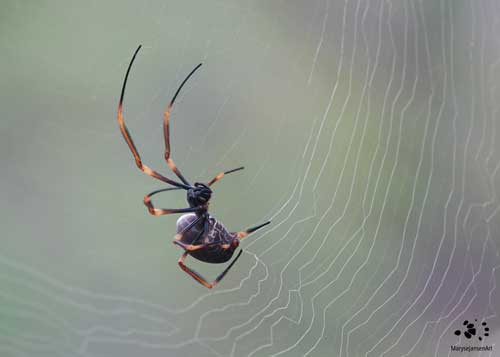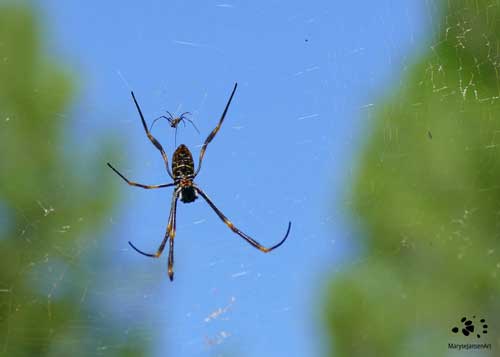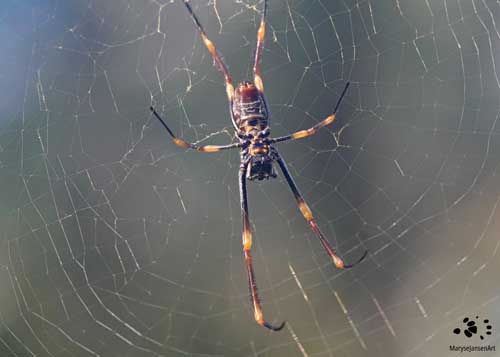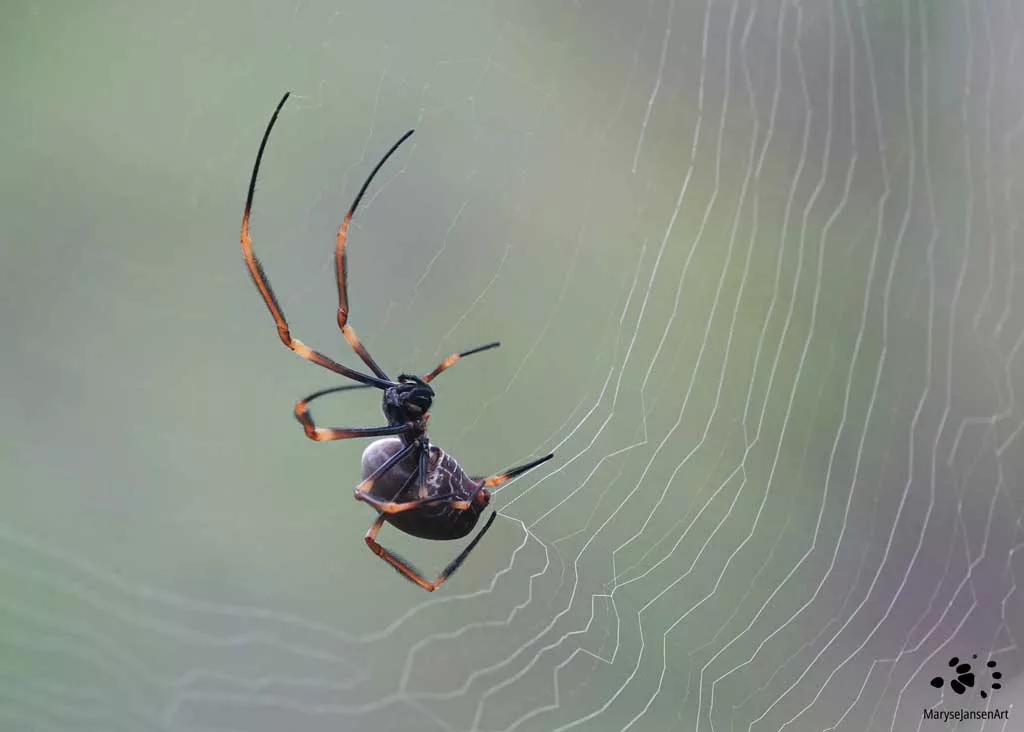Wildlife Photography by marysejansenart
Does the gigantic female really eat the little male after mating?

Golden Orb Weaver renamed as Tiger Spider
The Golden Orb Weaver is probably one of the most well known spiders in Australia, at least in northern and eastern Australia where they are the most common. These spiders are often seen in urban environments as well as in the bush. But while I am researching the species for this post I learn that since 2018 it has actually been reclassified and now listens to the name Tiger Spider! I don’t think many people know that, did you? I certainly didn’t!
So it looks like Golden Orb Weaver is likely going to stick around as a common name for a long time. The name makes sense as it refers to the beautiful golden coloured silk these spiders produce to weave their orb webs! The name Tiger Spider however, is also quite fitting, when you look at their dark brown and yellow banded legs. To be complete, the scientific name has changed from Nephila plumipes to Trichonephila plumipes, which means the spider has been assigned to a different genus.
Sexual Cannibalism in Tiger Spiders
These spiders are quite large, females have a body size of 2-4cm excluding the long legs. The males however, are tiny! It is easy for me to spot the female as she occupies the centre of her large web which can be up to 1.5m in diameter! Like so often happens, she has woven here web between trees on either side of the path. Usually they are high enough, but sometimes I do have to watch out as I might walk into it. In fact, this has happened to me a number of times! The webs are very strong, it literally feels as if you are bouncing off a trampoline!
When I look closer, I notice several males on the outer areas of the web. One of the males is close to the female, obviously looking for an opportunity to mate. Due to the difference in size, this is a risky business! The female could easily eat the male and when she doesn’t like him she wouldn’t hesitate to do so! This form of sexual cannibalism does occur, but not as often as many people think.

The males have developed some clever strategies to prevent being consumed by their partner. They prefer to approach the female when she’s feeding or molting because she is then not moving and a lot less likely to respond aggressively. In any instance, they tap on a strand of the web before approaching to test her reaction. If she is aggressive, the male either retreats or stays put until she relaxes and he can try again to come a bit closer. Since multiple males will mate with the female, each of the males will try to ensure their sperm has the best odds of success by mating longer and more frequently.
Finally, the female lays 300-3000 eggs and covers them in a sac of silk. She makes sure to keep it from the view of predators by hiding it, for instance, under a leaf. She also stays close by to guard it. When the little spiderlings hatch they spend about a week in a web together, which I like to think of as a little nursery. After that they each go their own way and begin to construct their own webs.
They are still very small and this is the time of their life that they are most vulnerable to predation. Mainly birds but also some insects will eat them. They grow by molting. This may happen up to 12 times, until mating season arrives. Then the spiders stop molting and thus growing. Interestingly, adults do generally not get preyed upon.

Weaving a Golden Web
During a walk I spot a web, occupying a large open space over a gully. Long, strong threads attach it to surrounding trees. In the centre of the web I spot the female, busy weaving and repairing her web as shown in the featured image. As I’m peering through my zoom lens I am truly fascinated to be witnessing how she pulls a thread of silk out of her abdomen with one of her back legs, pushing it outward and using her other back leg to connect it to another strand. With her other legs she keeps walking along, while she repeats the process over and over.
Her web doesn’t exactly appear very golden in colour. I have noticed the intensity of the colour can vary a lot. One factor is the sun, its rays can really make the web appear bright yellow. But right now, the sun doesn’t shine on it. But there can be more to it. Apparently the spiders are able to adjust the yellow pigment to match the light levels and colour of their background. The better camouflaged the web is, the more likely it is that the prey insects won’t notice it! On the other hand, it is also thought that the bright yellow strings in the sunlight may attract bees.
Although the webs are strong, the stickiness of the threads degrades fairly quickly. This is why the spiders are respinning parts of their webs on a daily basis. Obviously, when the web is damaged by the rain or by an encounter with a larger organism or a falling branch, there is more to do! To prevent too much damage on a regular basis, strong guard strands are put up near the web which serve as a barrier/warning system for example for birds flying into it – or humans walking into it! 😉
Join me on my walk and watch the amazing footage of the female Tiger Spider weaving her web in the latest episode of ‘Come for a walk in the Australian Bush’:
If you are interested in purchasing a print of ‘Tiger Spider Weaving her Web’ or would like to see what the image looks like on the various merchandise products, please head to my shop. If you’d prefer ‘Tiger Spider’, click shop here.


